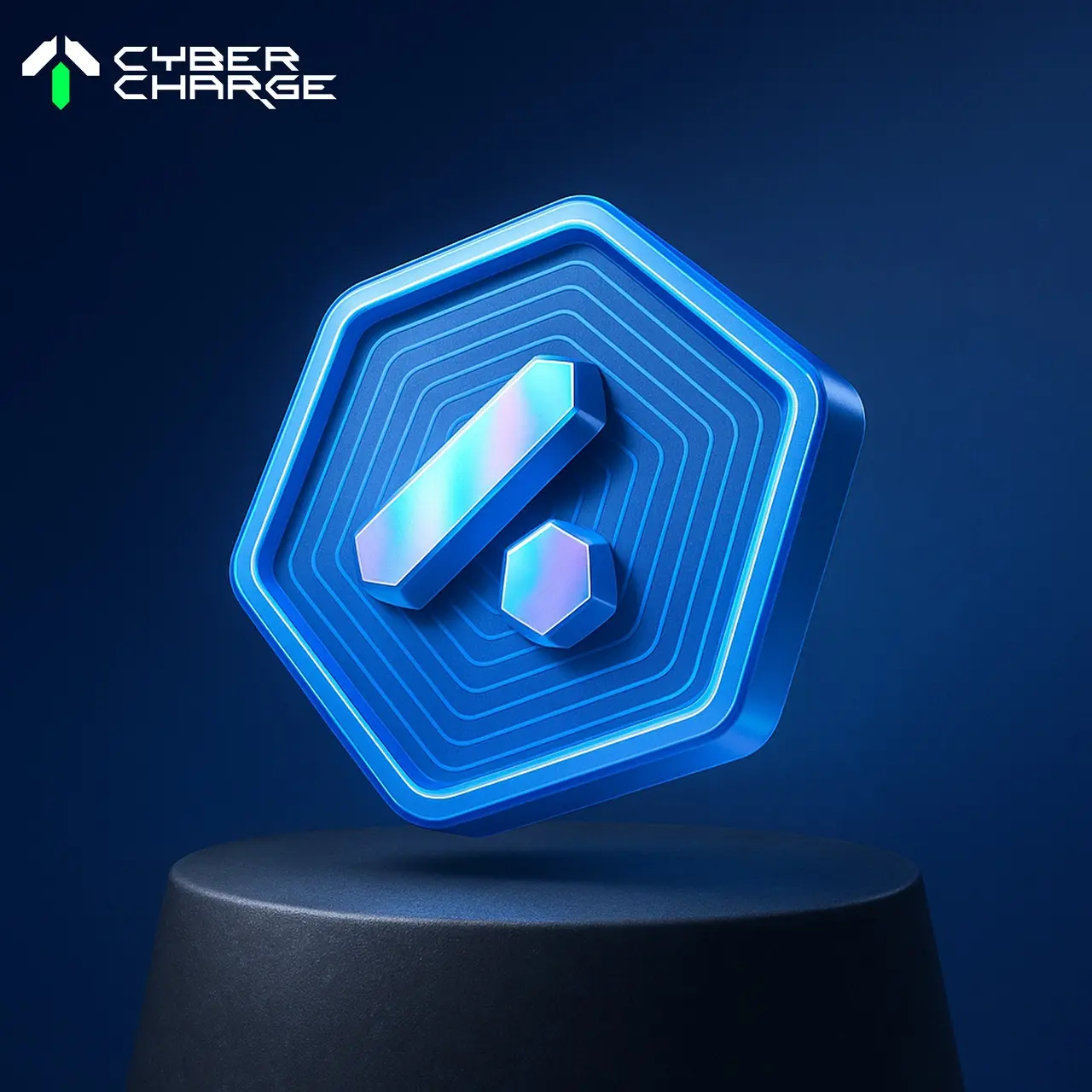How does CyberCharge distribute "rights" and "benefits"?
How does CyberCharge distribute "rights" and "benefits"?
Institutional Token Economy Design: Deflation, Self-Circulation and Incentive Order
In many Web3 projects, tokens are often seen as incentives or circulation mediums, but in CyberCharge, tokens are not only a reflection of value, but also an encoder of rules and power. CyberCharge has designed a complete token system with the idea of "system first", and built a set of economic order that does not rely on human intervention and can operate automatically through a deflationary model, incentive path and behaviour binding logic. Therefore, we will start from the total amount of tokens, the circulation mechanism, and the interrelationship between the three types of core tokens, and analyse how CyberCharge realises the closed loop of "behaviour is value, and rights are tokens" in its economic model.
CyberCharge's token system is made up of multiple tokens, each with different roles, but together they build a closed-loop economic order. Among them, the design of GEM, CPT and EST is the most representative, reflecting strong institutional characteristics.

Great Deflationary Design and Fuel Destruction Mechanism
GEM:
CyberCharge's tokenomics model is initially designed around the principle of high consumption and low release, and one of its core features is a strong deflationary logic. For CyberCharge, deflation is not an end in itself, but a value-regulating mechanism, that is, by making the token continue to "scarcity", giving more imaginative long-term revenue space to user behaviour. For example, the total amount of GEM, the core token in the platform, is capped at a low value range, which is set at about 5 billion in the current model. Users will continue to consume GEM in the process of participating in charging mining, ecological interaction, etc. A portion of the GEM is permanently burned, and the other part is returned to the mining pool as a follow-up incentive reserve. This use-and-burn design idea aims to achieve two goals: on the one hand, to maintain the scarcity and intrinsic support of the token by simultaneously reducing the market supply, and on the other hand, to gradually tilt the value towards real participants, so that the more it is used, the more it is fed.
Under the current scenario, the system also introduces a decreasing capacity adjustment mechanism. When the cumulative amount of GEM burned reaches certain thresholds, the mining output rate will decrease slightly. For example, when the total number of destroyed coins reaches 50 million, the output efficiency in the relevant scenario may be reduced by 1%, that is, calculated by a coefficient of 0.99. If 100 million pieces are burned, it will enter an iterative logic of 0.99 × 0.99, and gradually decrease. On the whole, the design intention is not to blindly suppress output, but to build a more controllable incentive release path that is closely linked to actual use. The release speed of GEM will be closer to the real rhythm of use, avoiding the cyclical problem of "a large amount of release in the early stage and a weak rise in the later stage". At present, the mechanism is still in the stage of continuous optimisation, and may be flexibly adjusted in the future based on community feedback and ecological performance. The ultimate goal is to match the token's liquidity strength with its usage activity, so that the value is more realistically anchored to behaviour rather than expectation.

EST:
As the exclusive token of the AIDOGGY ecosystem, EST is mainly used for the cultivation and interaction of virtual pets. In terms of function, it supports the core gameplay of dog raising, cleaning, charging, and upgrading; Every action is a validation of the value of EST. In addition, EST does not stop at the current application scenarios, and will expand to the production of Meme coins, NFT circulation and more innovative ways to play in the future, so that its value logic will shift from "tools" to "ecological blood". With the expansion of the ecological scale, the value anchoring of EST will be more three-dimensional and have more room for growth.

CPT vs. UCC:
A similar deflationary mechanism is also reflected in the design of the hash coin CPT. As the core token of the CyberCharge ecosystem, CPT plays multiple roles in behavioural output, consumption payment, and some governance scenarios. In the current scenario, the total release limit is no more than 100 billion, most of which will be released through user behaviour, and the rest will be used for ecological construction and incentive support. When a user consumes CPT in the purchase of props or participation in the mining pool, half of it will be destroyed, and the other half will be returned to the mining pool. This mechanism aims to bind behaviour and scarcity, forming a "use is contraction" supply feedback path. In addition, CPT also assumes the "fuel" function of UCC withdrawals. According to the current draft mechanism, users need to consume additional CPT when exchanging UCC to USDT, and all of them will be burned. This design sets the cost threshold for value outflow, and also helps to regulate the circulation rhythm of the system through continuous burndown. In general, the deflationary logic of CPT not only serves short-term incentives, but also plays the role of an "economic valve" at the institutional level, maintaining the balance and sustainability of the token system in the process of ecological expansion.

One Token, Four
Worlds In CyberCharge's economic system, GEM, CPT, and UCC are not simple functional tokens, but more like three on-chain stages that user behaviour traverses: instant output, power accumulation, and value fulfilment. They map both behaviours and the path of rights granted by the system, and are a set of endogenous circular devices that transform individual participation into system value.
GEM belongs to the "world of the moment".。 It is the entrance to the act and the carrier of immediate returns. When a user completes an operation, an interaction, or a real use in the ecosystem, they will immediately get GEM as feedback. This not only incentivises users to invest, but also continuously injects liquidity and activity into the platform. The existence of GEM allows ecological incentives to no longer rely on airdrops, speculation, or expectations, but are truly based on "behaviour is value". CPT belongs to the "world of the future". It represents the long-term rights and interests of users in the ecosystem, and is a delayed return after the precipitation of behavioural value. Users can convert GEM into CPT through mechanisms such as "Delivering Gems" in exchange for governance rights, dividend shares, or computing power metrics in the platform. The significance of CPT is that it gives the "people who remain in the system" the ability to make future claims, and is the institutional anchor that connects the participants with the direction of the evolution of the platform. It is used less for consumption and more for holding and accumulation, forming a weight distribution structure within the ecology.

EST, belongs to the "growing world". It carries companionship and nurturing - mainly circulated in AIDOGGY's dog raising, upgrading, cleaning and other scenarios. EST is the "energy" to level up your pet, and it is also a potential entry point for subsequent meme applications. It is not used in exchange for immediate benefits, but through daily accumulation and ecological participation, to create a more playable and malleable user path. With the expansion of the AIDOGGY ecosystem, the boundaries of EST will continue to expand, and its intrinsic value will be supported beyond behaviour. UCC belongs to the "real world". As a stable token that anchors the value of fiat currency, it is a bridge for users to exit the ecosystem, providing a clear path to value realisation. But this path is not free: users must consume CPT as "fuel" when withdrawing, and bear a certain value price. This mechanism effectively prevents cost-free arbitrage, and also forces users to rethink the "value of exit" before cashing out, thereby strengthening the value closed loop of the ecosystem.
The four constitute a complete behavioural economic cycle system: from input ➝ accumulation ➝ cash ➝ recycling, and constantly promote the coexistence of incentive efficiency and institutional order in token circulation. This is not only the design of an incentive model, but also a mechanism experiment of "binding behaviour to power and allowing participation to create order". CyberCharge is never just about "how to reward", but rather: who should own the future in a behaviour-driven on-chain world?
Outside the system, in the order
CyberCharge doesn't attempt to reshape governance with complex voting mechanisms or technical thresholds, nor does it see incentives as mere tools to attract traffic. What CyberCharge does is to preset a value logic for participants at the institutional level: rights, continuous contributions from real behaviours; Profit comes from the accurate mapping of the value of behaviour in the system. This token model does not rely on human management, but automatically completes resource allocation and order maintenance through mechanism design, that is, behaviour triggers incentives, accumulates precipitated rights, and exit requires a price. Behind every operation, it is not only the transaction and feedback, but also the implementation of the system and order. Perhaps what really deserves attention is not "how many coins are issued by CyberCharge", but rather that it tries to answer the question of how to build a self-consistent power structure and interest order through incentives without central control. This is a new distributive experiment, a model of order embedded in the system. CyberCharge, on the other hand, is just the beginning.
3.23K
1
The content on this page is provided by third parties. Unless otherwise stated, OKX TR is not the author of the cited article(s) and does not claim any copyright in the materials. The content is provided for informational purposes only and does not represent the views of OKX TR. It is not intended to be an endorsement of any kind and should not be considered investment advice or a solicitation to buy or sell digital assets. To the extent generative AI is utilized to provide summaries or other information, such AI generated content may be inaccurate or inconsistent. Please read the linked article for more details and information. OKX TR is not responsible for content hosted on third party sites. Digital asset holdings, including stablecoins and NFTs, involve a high degree of risk and can fluctuate greatly. You should carefully consider whether trading or holding digital assets is suitable for you in light of your financial condition.
